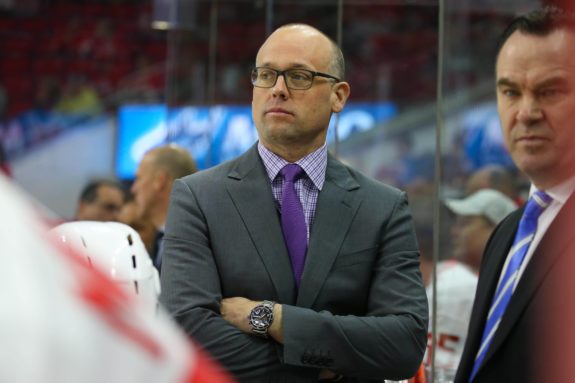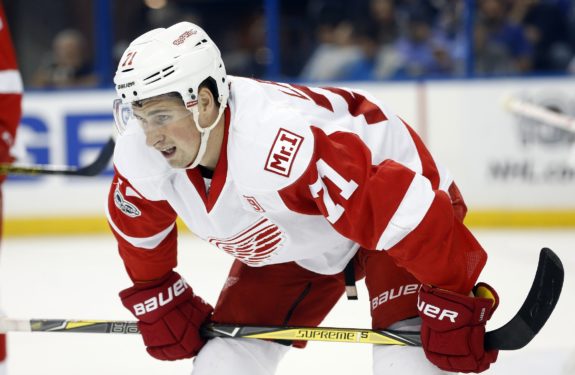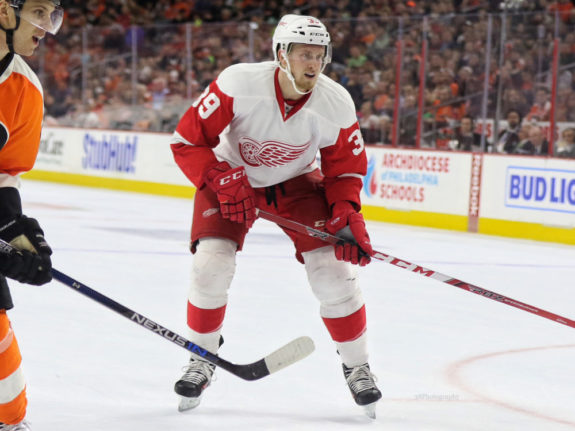Tuesday night, the Detroit Red Wings began their eight-game preseason slate with a 4-2 defeat at the hands of the Boston Bruins. They were outshot 34-22, including 26-12 through two periods. The shot gap was a continuation of an unhealthy trend from last season, which saw Detroit finish with a minus-2.1 ratio in terms of shots-for (28.5) and shots-against (30.6) per game.
This was indicative of their tendency to chase the game on most nights.
In this particular contest, only five forwards finished with a possession rating above 52 percent. Among those up front who were on the ice for ten or more Red Wings attempts, Dylan Larkin (61.11%) and Anthony Mantha (57.89%) led the charge scoring each of Detroit’s goals.
While this performance came in exhibition play and the brand of hockey was not the most intense, it was clear that head coach Jeff Blashill wanted to see how these two would gel during game action.
They spent all of training camp together on the same line for a reason.
#RedWings lines:
Tatar-Zetterberg-Nyquist
Abdelkader-Larkin-Mantha
Parenteau-Nielsen-Helm
Bertuzzi/Witkowski-Sheahan-Glendening— Ansar Khan (@AnsarKhanMLive) September 15, 2017
It is encouraging on the surface to see these two get looks together in the preseason. However, with Blashill, nothing is usually consistent or guaranteed for younger players in terms of line combinations or roles. Larkin started at center last season, moved to wing on multiple lines, and sometimes played in the bottom six with grinders.
Mantha was benched or was a healthy scratch on occasion for a lack of, wait for it, his compete level.

Competitiveness is an important trait to mold in younger players. However, older veterans who have made their share of mistakes have not been subject to the same standard of scrutiny in Blashill’s tenure. Some have continued to log minutes unjustifiable by their weak production.
It’s becoming clear now that for the Red Wings to have any ounce of success this season, they must rely on their future building blocks to take the next step. Detroit can do this by casting their young talent in the roles that they were drafted for.
Penciling in Larkin as a top-six center does the trick.
Larkin Riding Momentum
When Larkin was put back in the middle after the trade deadline last season, his performance seemed to indicate that he had finally turned the corner after a lengthy dry spell. The University of Michigan alumnus turned in consistent outings that were rare over the prior 14 months, a time period that left many questions as to what Larkin’s ceiling truly was.
In the first 48 games of his sophomore campaign, Larkin scored just 1.38 points-per-60 minutes, continuing his rookie slump from 2015-16. In 102 games from the beginning of the slump on January 1, 2016 to March 1, 2017, he totaled 1.44 points-per-60, 10th among Detroit forwards in that span.
His hot start as a 19-year-old that saw him score 13 goals and 25 points in his first 37 games seemed like a distant memory.
However, through the last 21 games of 2016-17, something clicked at center and he was back to his old self.

In the 21 contests, the Belle Tire product scored five of the 17 goals he potted all season and totalled 13 points, a 2.16 points-per-60 pace. This was more in line with the pace he played at in his electrifying rookie campaign, where he scored 23 goals and ran at 2.04 points-per-60 rate.
While his possession rating during the span was nothing to write home about (48.61%), the raw production served as a prelude to how Larkin would perform at the 2017 IIHF World Championship.
There, he had quality talent on his wings.
With Blashill on the bench as the head coach of Team USA, Larkin scored two goals and added ten points in eight games. He was able to show more of that playmaking ability that eluded him last season, an encouraging sign for someone who had just 15 assists in 80 games.
The now-21-year-old’s top-six positioning in the exhibition season bodes well for him to get consistent reps with another quality offensive talent on his wing come the regular campaign.
No, it is not Justin Abdelkader.
Mantha Looking to Break Out
Now 23 years old, Mantha is coming into the 2017-18 campaign from a completely opposite direction. He broke his finger in a fight with current teammate Luke Witkowski during a game against the Tampa Bay Lightning on March 30, effectively ending his season early. He was also not on the best of runs leading up to the injury.
Mantha became arguably the best sniper on the team last season in his first 30 games. He scored 11 goals and 22 points and looked to be on his way to a promising 20-goal campaign. Unfortunately, his six-goal performance in his final 30 games left a damper on what was an exciting beginning to his young career.
However, there is a case for some reassurance due to his supreme possession statistics and shot generation on a team that had a difficult time getting pucks to the net.

While he did play 522:40 with Henrik Zetterberg last season and hovered around a 50% rating in 269:58 without him, his effect on the captain should not be dismissed. Away from Mantha, “Z” posted a 46.99% Corsi-for percentage. With him on his right wing, that shot up to an impressive 55.12%.
Overall, the former Val-D’or Foreur posted a relative on-ice Corsi rating of plus-6.5%, the best on the team among skaters who played at least 40 games. This was quite indicative of his impact on “Z.”
This season will be another test for him coming off of a disappointing end to 2016-17. Mantha will likely be playing away from Zetterberg as Tomas Tatar and Gustav Nyquist remain on the top line. It will be interesting to see if he can have the same impact on his new linemate as he did the captain while increasing his individual offensive totals in the process.
It Takes Two
Mantha and Larkin both have a great deal to prove this season. Each of their contracts expire next summer and both will be looking for major pay raises from their entry-level deals. Larkin was a below-average possession player last campaign, but Mantha was an impressive one. The latter is coming into this season on a down note, while the former is riding a wave of confidence playing his natural position.
Both have played just 65:07 together combined the past two campaigns, so there is not much familiarity. Chemistry can form quickly, however. Before Mantha’s surge with Zetterberg the two played just 4:48 together in 2015-16.
While Larkin isn’t the dominant two-way force the latter is, his speed is a valuable weapon that can complement the overlooked, powerful strides Mantha possesses.
His shot is a modest strength as well.
It’s fitting that both Larkin and Mantha could end up on a line together in the top six. As a duo, they have the opportunity to feed off of each other and collectively prove to the organization that they can be cornerstones going forward.
However, the onus will be on Blashill to make sure that both are in the best possible position to succeed consistently. This will be vital to Detroit in finding out what they ultimately have in the two forwards.
Together, they could form something special.
Statistics courtesy of NaturalStatTrick.com and HockeyStats.ca